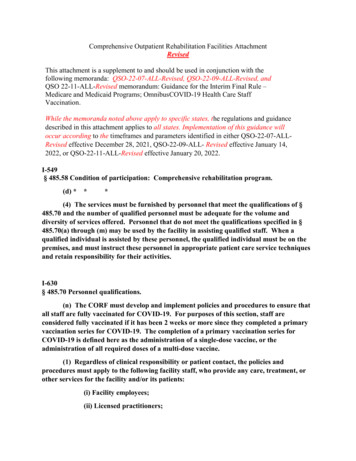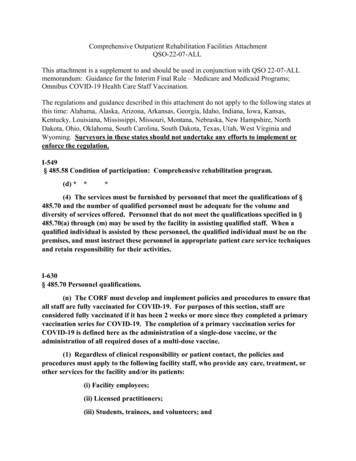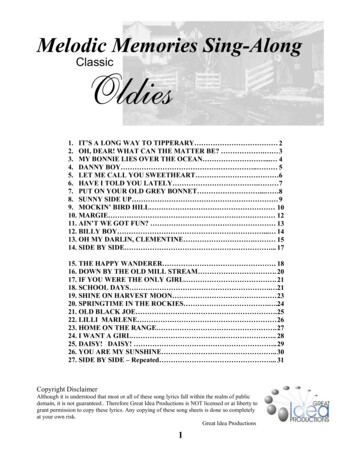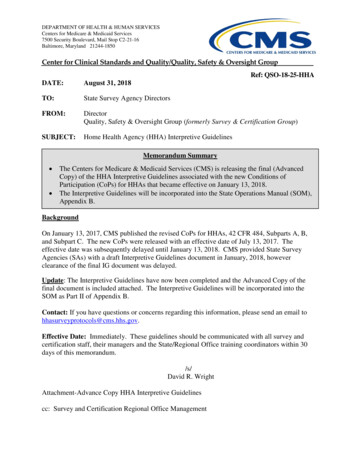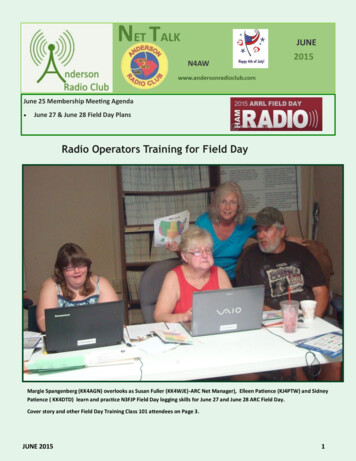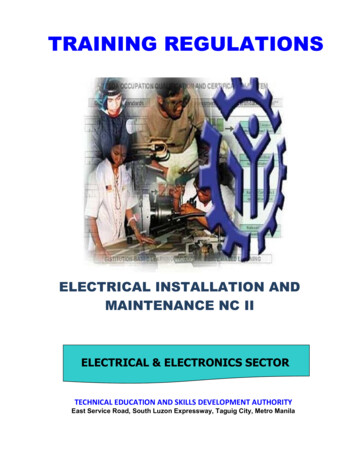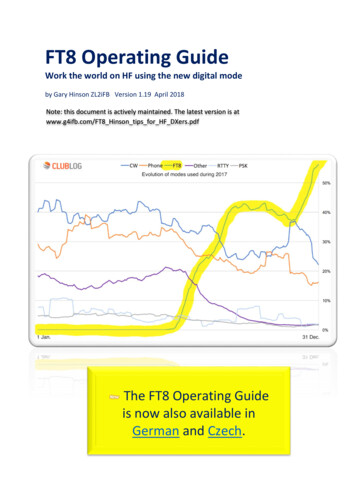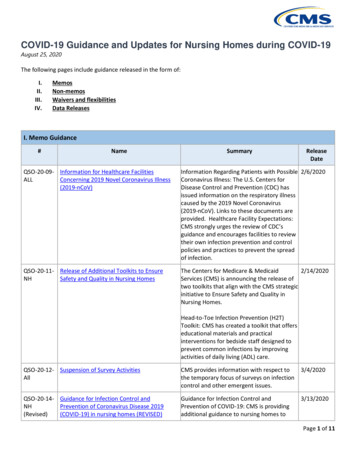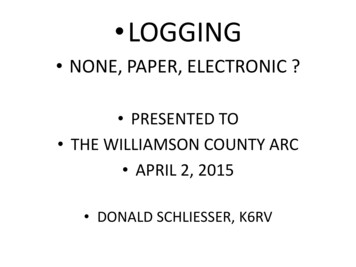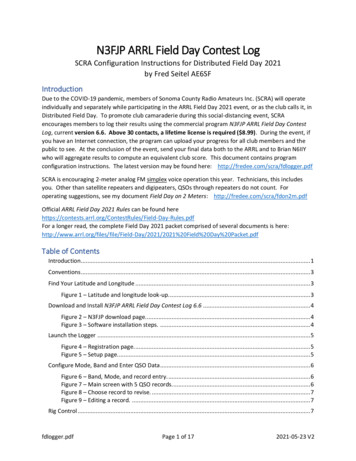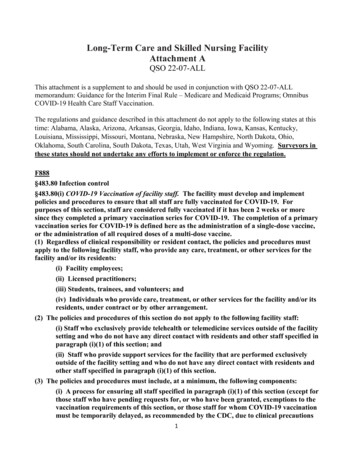
Transcription
Long-Term Care and Skilled Nursing FacilityAttachment AQSO 22-07-ALLThis attachment is a supplement to and should be used in conjunction with QSO 22-07-ALLmemorandum: Guidance for the Interim Final Rule – Medicare and Medicaid Programs; OmnibusCOVID-19 Health Care Staff Vaccination.The regulations and guidance described in this attachment do not apply to the following states at thistime: Alabama, Alaska, Arizona, Arkansas, Georgia, Idaho, Indiana, Iowa, Kansas, Kentucky,Louisiana, Mississippi, Missouri, Montana, Nebraska, New Hampshire, North Dakota, Ohio,Oklahoma, South Carolina, South Dakota, Texas, Utah, West Virginia and Wyoming. Surveyors inthese states should not undertake any efforts to implement or enforce the regulation.F888§483.80 Infection control§483.80(i) COVID-19 Vaccination of facility staff. The facility must develop and implementpolicies and procedures to ensure that all staff are fully vaccinated for COVID-19. Forpurposes of this section, staff are considered fully vaccinated if it has been 2 weeks or moresince they completed a primary vaccination series for COVID-19. The completion of a primaryvaccination series for COVID-19 is defined here as the administration of a single-dose vaccine,or the administration of all required doses of a multi-dose vaccine.(1) Regardless of clinical responsibility or resident contact, the policies and procedures mustapply to the following facility staff, who provide any care, treatment, or other services for thefacility and/or its residents:(i) Facility employees;(ii) Licensed practitioners;(iii) Students, trainees, and volunteers; and(iv) Individuals who provide care, treatment, or other services for the facility and/or itsresidents, under contract or by other arrangement.(2) The policies and procedures of this section do not apply to the following facility staff:(i) Staff who exclusively provide telehealth or telemedicine services outside of the facilitysetting and who do not have any direct contact with residents and other staff specified inparagraph (i)(1) of this section; and(ii) Staff who provide support services for the facility that are performed exclusivelyoutside of the facility setting and who do not have any direct contact with residents andother staff specified in paragraph (i)(1) of this section.(3) The policies and procedures must include, at a minimum, the following components:(i) A process for ensuring all staff specified in paragraph (i)(1) of this section (except forthose staff who have pending requests for, or who have been granted, exemptions to thevaccination requirements of this section, or those staff for whom COVID-19 vaccinationmust be temporarily delayed, as recommended by the CDC, due to clinical precautions1
and considerations) have received, at a minimum, a single-dose COVID-19 vaccine, orthe first dose of the primary vaccination series for a multi-dose COVID-19 vaccine priorto staff providing any care, treatment, or other services for the facility and/or itsresidents;(ii) A process for ensuring that all staff specified in paragraph (i)(1) of this section arefully vaccinated for COVID-19, except for those staff who have been granted exemptionsto the vaccination requirements of this section, or those staff for whom COVID-19vaccination must be temporarily delayed, as recommended by the CDC, due to clinicalprecautions and considerations;(iii) A process for ensuring the implementation of additional precautions, intended tomitigate the transmission and spread of COVID-19, for all staff who are not fullyvaccinated for COVID-19;(iv) A process for tracking and securely documenting the COVID-19 vaccination statusof all staff specified in paragraph (i)(1) of this section;(v) A process for tracking and securely documenting the COVID-19 vaccination status ofany staff who have obtained any booster doses as recommended by the CDC;(vi) A process by which staff may request an exemption from the staff COVID-19vaccination requirements based on an applicable Federal law;(vii) A process for tracking and securely documenting information provided by thosestaff who have requested, and for whom the facility has granted, an exemption from thestaff COVID-19 vaccination requirements;(viii) A process for ensuring that all documentation, which confirms recognized clinicalcontraindications to COVID-19 vaccines and which supports staff requests for medicalexemptions from vaccination, has been signed and dated by a licensed practitioner, whois not the individual requesting the exemption, and who is acting within their respectivescope of practice as defined by, and in accordance with, all applicable State and locallaws, and for further ensuring that such documentation contains:(A) All information specifying which of the authorized COVID-19 vaccines areclinically contraindicated for the staff member to receive and the recognizedclinical reasons for the contraindications; and(B) A statement by the authenticating practitioner recommending that the staffmember be exempted from the facility’s COVID-19 vaccination requirements forstaff based on the recognized clinical contraindications;(ix) A process for ensuring the tracking and secure documentation of the vaccinationstatus of staff for whom COVID-19 vaccination must be temporarily delayed, asrecommended by the CDC, due to clinical precautions and considerations, including, butnot limited to, individuals with acute illness secondary to COVID-19, and individualswho received monoclonal antibodies or convalescent plasma for COVID-19 treatment;and(x) Contingency plans for staff who are not fully vaccinated for COVID-19.GUIDANCEDEFINITIONS2
“Booster” per Centers for Disease Control and Prevention (CDC), refers to a dose of vaccineadministered when the initial sufficient immune response to the primary vaccination series is likely tohave waned over time.“Clinical contraindications” refer to conditions or risks that preclude the administration of atreatment or intervention. With regard to recognized clinical contraindications to receiving a COVID19 vaccine, facilities should refer to the CDC informational document, Summary Document forInterim Clinical Considerations for Use of COVID-19 Vaccines Currently Authorized in the UnitedStates, accessed at mmary-interim-clinicalconsiderations.pdf. For COVID-19 vaccines, according to CDC, a vaccine is clinicallycontraindicated if an individual has a severe allergic reaction (e.g., anaphylaxis) after a previous doseor to a component of the COVID-19 vaccine or an immediate (within 4 hours of exposure) allergicreaction of any severity to a previous dose or known (diagnosed) allergy to a component of thevaccine.“Fully vaccinated” refers to staff for whom it has been 2 weeks or more since completion of theirprimary vaccination series for COVID-19.“Primary Vaccination Series” refers to staff who have received a single-dose vaccine or all requireddoses of a multi-dose vaccine for COVID-19.“Staff” refers to individuals who provide any care, treatment, or other services for the facility and/orits residents, including employees; licensed practitioners; adult students, trainees, and volunteers; andindividuals who provide care, treatment, or other services for the facility and/or its residents, undercontract or by other arrangements. This also includes individuals under contract or by arrangementwith the facility, including hospice and dialysis staff, physical therapists, occupational therapists,mental health professionals, licensed practitioners, or adult students, trainees, or volunteers. Staffwould not include anyone who provides only telemedicine services or support services outside of thefacility and who does not have any direct contact with residents and other staff specified in paragraph§483.80(i)(2). Nursing homes are not required to ensure the vaccination of individuals who veryinfrequently provide ad hoc non-healthcare services (such as annual elevator inspection), or servicesthat are performed exclusively off-site.“Temporarily delayed vaccination” refers to vaccination that must be temporarily postponed, asrecommended by CDC, due to clinical precautions and considerations, including, but not limited to,individuals with acute illness secondary to COVID-19, or individuals who received monoclonalantibodies or convalescent plasma for COVID-19 treatment in the last 90 ckgroundTo protect LTC residents from COVID-19, each facility must develop and implement policies andprocedures as specified in §483.80(i) to ensure that all LTC staff are fully vaccinated against COVID19.Per §483.80(i)(2), the requirements in this section do not apply to individuals who provide supportservices from a remote location and who do not enter the facility or have contact with residents or3
staff of the facility. For example, this may include a telehealth provider who does not visit thefacility, such as a consultant conducting a telehealth visit, or a radiologist who reads x-rays outside ofthe facility, while the x-ray technician who performed the x-ray onsite will be subject to theserequirements.The vaccine may be offered and provided directly by the facility or, if unavailable at the facility, staffmust obtain COVID-19 vaccines through a pharmacy partner, local health department, or otherappropriate health entity. See requirements at 42 CFR §483.80(d)(3), at F887.Surveying for Compliance:Surveyors will begin surveying for compliance 30 days from the date of issuance of the QSO-22-07ALLmemorandum. Surveyors should focus on staff that regularly work in the facility (e.g., weekly),using a phased-in approach as described below.Vaccination Enforcement:CMS expects all facilities’ staff to have received the appropriate number of doses by the timeframesspecified in the memorandum unless exempted as required by law. Facility staff vaccination ratesunder 100% constitute non-compliance under the rule. Non-compliance does not necessarily leadto termination, and facilities will generally be given opportunities to return to compliance.Within 30 days after the issuance of the memorandum1, if a facility demonstrates: Policies and procedures are developed and implemented for ensuring all facility staff,regardless of clinical responsibility or resident contact are vaccinated for COVID-19,including all required components of the policies and procedures specified below (e.g., relatedto tracking staff vaccinations, documenting medical and religious exemptions, etc.); and 100% of staff have received at least one dose of COVID-19 vaccine or have a pending requestfor, or have been granted a qualifying exemption, or are identified as having a temporary delayas recommended by the CDC, the facility is compliant under the rule. Less than 100% of all staff have received at least one dose of COVID-19 vaccine, or have apending request for, or have been granted a qualifying exemption, or are identified as having atemporary delay as recommended by the CDC, the facility is non-compliant under the rule.The facility will receive notice 2 of their non-compliance with the 100% standard. A facilitythat is above 80% and has a plan to achieve a 100% staff vaccination rate within 60 dayswould not be subject to an enforcement action. States should work with their CMS locationfor cases that exceed these thresholds, yet pose a threat to patient health and safety. Facilitiesthat do not meet these parameters could be subject to additional enforcement actionsdepending on the severity of the deficiency and the type of facility (e.g., plans of correction,civil monetary penalties, denial of payment, termination, etc.).Within 60 days after the issuance of the memorandum3 if a facility demonstrates:If 30 days falls on a weekend or designated federal holiday, CMS will use enforcement discretion to initiate complianceassessments the next business day.2This information will be communicated through the CMS Form-2567, using the Automated Survey Process Environment(ASPEN) tag F888.3If 60 days falls on a weekend or designated federal holiday, CMS will use enforcement discretion to initiate complianceassessments the next business day.14
Policies and procedures are developed and implemented for ensuring all facility staff,regardless of clinical responsibility or resident contact are vaccinated for COVID-19,including all required components of the policies and procedures specified below (e.g., relatedto tracking staff vaccinations, documenting medical and religious exemptions, etc.); and100% of staff have received the necessary doses to complete the vaccine series (i.e., one doseof a single-dose vaccine or all doses of a multiple vaccine series) or have been granted aqualifying exemption, or are identified as having a temporary delay as recommended by theCDC, the facility is compliant under the rule.Less than 100% of all staff have received at least one dose of a single-dose vaccine, or alldoses of a multiple vaccine series, or have been granted a qualifying exemption, or areidentified as having a temporary delay as recommended by the CDC, the facility is noncompliant under the rule. The facility will receive notice 4 of their non-compliance with the100% standard. A facility that is above 90% and has a plan to achieve a 100% staffvaccination rate within 30 days would not be subject to an enforcement action. States shouldwork with their CMS location for cases that exceed these thresholds, yet pose a threat topatient health and safety. Facilities that do not meet these parameters could be subject toadditional enforcement actions depending on the severity of the deficiency and the type offacility (e.g., plans of correction, civil monetary penalties, denial of payment, termination,etc.).Within 90 days and thereafter following issuance of the memorandum, facilities failing tomaintain compliance with the 100% standard may be subject to enforcement action.Policies and Procedures:The facility’s policies and procedures must address each of the components specified in §483.80(i)(3).Requirements which must be implemented within 30 days of the issuance of the memorandum:§483.80(i)(3)(i): Requires the facility to have a process for ensuring all staff (as defined above) havereceived at least a single-dose, or the first dose of a multi-dose COVID-19 vaccine series, or have apending, or have been granted a qualifying exemption, or identified as having a delay asrecommended by the CDC, prior to providing any care, treatment, or other services for the facilityand/or its residents.§483.80(i)(3)(iii): Requires facilities to ensure those staff who are not yet fully vaccinated, or whohave a pending or been granted an exemption, or who have a temporary delay as recommended by theCDC, adhere to additional precautions that are intended to mitigate the spread of COVID-19. Thereare a variety of actions or job modifications a facility can implement to potentially reduce the risk ofCOVID-19 transmission including, but not limited to: Reassigning staff who have not completed their primary vaccination series to non-patient careareas, to duties that can be performed remotely (i.e., telework), or to duties which limitexposure to those most at risk (e.g., assigning to residents who are not immunocompromised,unvaccinated).This information will be communicated through the CMS Form-2567, using the Automated Survey Process Environment(ASPEN) tag F88845
Requiring staff who have not completed their primary vaccination series to follow additionalCDC-recommended precautions, such as adhering to universal source control and physicaldistancing measures in areas that are restricted from patient access (e.g., staff meeting rooms,kitchen), even if the facility or service site is located in a county with low to moderatecommunity transmission.Requiring at least weekly testing for exempted staff, and staff who have not completed theirprimary vaccination series for until the regulatory requirement is met, regardless of whetherthe facility or service site is located in a county with low to moderate community transmission,in addition to following CDC recommendations for testing unvaccinated staff in facilitieslocated in counties with substantial to high community transmission.Requiring staff who have not completed their primary vaccination series to use a NIOSHapproved N95 or equivalent or higher-level respirator for source control, regardless of whetherthey are providing direct care to or otherwise interacting with patients.Facilities may also consult with their local health departments to identify other actions that canpotentially reduce the risk of COVID-19 transmission from unvaccinated staff.§483.80(i)(3)(iv)-(v) and (ix) Process for tracking staff vaccine status:The facility must track and securely document: each staff member’s vaccination status (this should include the specific vaccine received, andthe dates of each dose received, or the date of the next scheduled dose for a multi-dosevaccine); any staff member who has obtained any booster doses (this should include the specific vaccinebooster received and the date of the administration of the booster); staff who have been granted an exemption from vaccination (this should include the type ofexemption and supporting documentation); requirements by the facility; and staff for whom COVID-19 vaccination must be temporarily delayed. For temporary delays,facilities should track when the identified staff can safely resume their vaccination.Facilities that employ or contract staff who telework full-time (e.g., 100 percent of their time isremote from sites of resident care and staff who do work at sites of care) should identify theseindividuals as a part of implementing the facility’s policies and procedures, but those individuals arenot subject to the vaccination requirements. Note, however, that these individuals may be subject toother federal requirements for COVID-19 vaccination. Facilities have the flexibility to use thetracking tools of their choice; however, they must provide evidence of this tracking for surveyorreview. Additionally, facilities’ tracking mechanism should clearly identify each staff’s role, assignedwork area, and how they interact with residents. This includes staff who are contracted, volunteers, orstudents. The survey team will provide a vaccine matrix that may be used by the facility. This can beused to determine how unvaccinated staff are assigned, to determine if additional precautions havebeen implemented to prevent COVID-19 transmission.NOTE: See requirements at §483.80(d)(3) in F887 for verification and maintenance ofdocumentation related to staff COVID-19 vaccination.6
§483.80(i)(3)(vi) - (viii) Vaccination Exemptions:Facilities must have a process by which staff may request exemption from COVID-19 vaccinationbased on an applicable Federal law. This process should clearly identify how an exemption isrequested, and to whom the request must be made. Additionally, facilities must have a process forcollecting and evaluating such requests, including the tracking and secure documentation ofinformation provided by those staff who have requested exemption, the facility’s determination of therequest, and any accommodations that are granted.Note: Staff who are unable to furnish proper exemption documentation must be vaccinated or thefacility must follow the actions for unvaccinated staff.Medical Exemptions:Certain allergies or recognized medical conditions may provide grounds for a medical exemption.With regard to recognized clinical contraindications to receiving a COVID-19 vaccine, facilitiesshould refer to the CDC informational document, Summary Document for Interim ClinicalConsiderations for Use of COVID-19 Vaccines Currently Authorized in the United States, accessed summary-interim-clinical-considerations.pdf. Ingeneral, CDC considers a history of a severe allergic reaction (e.g., anaphylaxis) after a previous doseor to a component of the COVID-19 vaccine, or an immediate (within 4 hours of exposure) allergicreaction of any severity to a previous dose, or known (diagnosed) allergy to a component of theCOVID-19 vaccine, to be a contraindication to vaccination with COVID-19 vaccines.Medical exemption documentation must specify which authorized or licensed COVID-19 vaccine isclinically contraindicated for the staff member and the recognized clinical reasons for thecontraindication. The documentation must also include a statement recommending that the staffmember be exempted from the facility’s COVID-19 vaccination requirements based on the medicalcontraindications.A staff member who requests a medical exemption from vaccination must provide documentationsigned and dated by a licensed practitioner acting within their respective scope of practice and inaccordance with all applicable State and local laws. The individual who signs the exemptiondocumentation cannot be the same individual requesting the exemption.Facilities must have a process to track and secure documentation of the vaccine status of staff whosevaccine is temporarily delayed. CDC recommends a temporary delay in administering the COVID-19vaccination due to clinical precautions and considerations such as individuals with acute illnesssecondary to COVID-19 illness, and individuals who received monoclonal antibodies, or convalescentplasma for COVID-19 treatment.Non-Medical Exemptions, Including Religious Exemptions:Requests for non-medical exemptions, such as a religious exemption in accordance with Title VII,must be documented and evaluated in accordance with applicable federal law and each facility’spolicies and procedures. We direct providers and suppliers to the Equal Employment OpportunityCommission (EEOC) Compliance Manual on Religious section-12-religious-discrimination) for information onevaluating and responding to such requests.7
Note: Surveyors will not evaluate the details of the request for a religious exemption, nor therationale for the facility’s acceptance or denial of the request. Rather, surveyors will review to ensurethe facility has an effective process for staff to request a religious exemption for a sincerely heldreligious belief.Accommodations of Unvaccinated Staff with a Qualifying Exemption:While accommodations could be appropriate under certain limited circumstances, no accommodationshould be provided that is not legally required or if it is requested solely to evade vaccination. Forindividual staff members that have valid reasons for exemption, the facility can address thoseindividually. An example of an accommodation for an unvaccinated employee with a qualifyingexemption could include mandatory routine COVID-19 testing in accordance with OSHA and CDCguidelines, physical distancing from co-workers and patients, re-assignment or modification of duties,teleworking, or a combination of these actions. Accommodations can be addressed in the facility’spolicies and procedures.Staff who have been granted an exemption to COVID-19 vaccination requirements should adhere tonational infection prevention and control standards for unvaccinated health care personnel. Foradditional information see CDC’s Interim Infection Prevention and Control Recommendations forHealthcare Personnel During the Coronavirus Disease 2019 (COVID-19) Pandemic webpage.§483.80(i)(3)(x) Contingency Plans:Facilities are required to have contingency plans for staff who are not fully vaccinated. Contingencyplans should include actions that the facility would take when staff have indicated that they will notget vaccinated and do not qualify for an exemption. Contingency plans should also address staff whoare not fully vaccinated due to an exemption or temporary delay in vaccination, such as through theadditional precautions required at §483.80(i)(3)(iii). Facilities should prioritize contingency plans forthose staff that have obtained no doses of any vaccine over staff that have received a single dose of amulti-dose vaccine. For example, contingency plans could include a deadline for staff to haveobtained their first dose of a multi-dose vaccine. The plans should also indicate the actions thefacility will take if the deadline is not met, such as actively seeking replacement staff throughadvertising or obtaining temporary vaccinated staff until permanent vaccinated replacements can befound.Regulatory Provisions implemented 60 days after the issuance of the memorandum*:§483.80(i)(3)(ii): Requires facilities to have a process for ensuring that all staff specified in paragraph(i)(1) of this section are fully vaccinated for COVID-19, except for those staff who have been grantedexemptions to the vaccination requirements of this section, or those staff for whom COVID-19vaccination must be temporarily delayed, as recommended by CDC, due to clinical precautions andconsiderations.* If 60 days falls on a weekend or designated Federal Holiday, CMS will use enforcement discretionto initiate compliance assessments the next business day.INVESTIGATIVE PROCEDURESUse the Infection Prevention, Control & Immunizations Facility Task, along with the aboveinterpretive guidance, when determining if the facility meets the requirements for, or investigatingconcerns related to COVID-19 vaccination of staff. Surveyors should focus investigations on staff8
that provide services in the facility on a regular (e.g., weekly) basis.Survey Process Updates for tag F888:To determine compliance with §483.80(i), surveyors will request the facility’s COVID-19 vaccinationpolicies and procedures, the number of resident and staff COVID-19 cases over the last 4 weeks, anda list of all staff and their vaccination status. The staff list must include the percentage of vaccinatedstaff, using the vaccine matrix provided by the survey team, and the position or role of each staffmember, including staff (facility staff, contracted staff, volunteers, or students) who are or are likelyto be in contact with residents or other staff, regardless of frequency.CMS will update the CMS-20054: “Infection Prevention, Control & Immunizations” Facility Task toinclude the new requirement at F888 for staff COVID-19 vaccination. Additionally, CMS will updateassociated survey documents, which will be found under the “Survey Resources” link in theDownloads Section of the CMS Nursing Homes website. The updated documents will also be addedto the Long-Term Care Survey Process software application. Surveyors will review for compliancewith this requirement on all initial certification, standard recertification surveys, as well as allcomplaint surveys.Offsite Preparation – CDC NHSN Data Verification:Surveyors should verify facility reporting of vaccine data to NHSN as a part of offsite preparationprior to going onsite for any initial, certification, or complaint survey. This will help them determineif there are inaccuracies in the facility’s vaccine NHSN reporting or with the facility’s process fortracking and securely documenting the COVID-19 vaccination status for all staff [per§483.80(i)(3)(iv)]. Surveyors can obtain the percent of staff who received a completed COVID-19vaccination for any facility by accessing the file through this link, which is also posted on theCOVID-19 Nursing Home Data - Centers for Medicare & Medicaid Services Data (cms.gov)webpage (click on the link in the section that states “Listing of vaccination rates for individual nursinghomes”).In the file, each nursing home’s percent of staff vaccinated as reported to NHSN is listed in thecolumn titled, “Recent Percentage of Staff who are Fully Vaccinated”.The percent of staff vaccinated as reported through NHSN and as identified through the onsite surveyshould be reasonably consistent, although the numbers may not be exactly the same. For example,there is a time lag between when facilities submit data to NHSN and when the data is posted publicly.Therefore, the information presented to the surveyor may differ from the data posted publicly. If the percent of staff vaccinated from both sources (NHSN and onsite) is reasonablyconsistent (e.g., within 10% of each other), no further investigation is required for datatracking or reporting. If the percent of staff vaccinated differs between both sources (e.g., greater than 10%variation), surveyors should interview the facility and review the documentation to determinewhich source is incorrect, and the facility’s explanation for the discrepancy.o If the surveyor determines that the information presented to the surveyor is incorrect(and NHSN is correct), or both sources are incorrect, this likely demonstrates thefacility’s failure to have a process for tracking and securely documenting the COVID19 vaccination status for all staff [per §483.80(i)(3)(iv)], and F-888 should be cited.9
o If the surveyor determines that the information reported to NHSN is incorrect (and theinformation reviewed onsite is correct), the surveyor should instruct the facility toimmediately correct the information in the NHSN system. If the surveyor identifiesthat a data field is blank, instruct facilities to obtain additional information onsubmitting data to NHSN by emailing NH COVID Data@cms.hhs.gov.NOTE: Surveyors should be aware that the determination that one source is incorrectdoes not automatically infer that the other source is correct.Citing Noncompliance - Scope and Severity:Facility staff vaccination rates under 100% constitute non-compliance under the rule. The levelof severity will be cited based on the level of harm, or likelihood of harm for residents. For example,facilities with a high percentage of unvaccinated staff, several COVID-19 infections, and gaps in theirpolicy and procedures, represent a higher risk of harm to residents. Therefore, these facilities wouldbe cited at a higher level of
Long-Term Care and Skilled Nursing Facility . Attachment A . QSO 22-07-ALL . This attachment is a supplement to and should be used in conjunction with QSO 22-07-ALL memorandum: Guidance for the Interim Final Rule - Medicare and Medicaid Programs; Omnibus COVID-19 Health Care Staff Vaccination.

